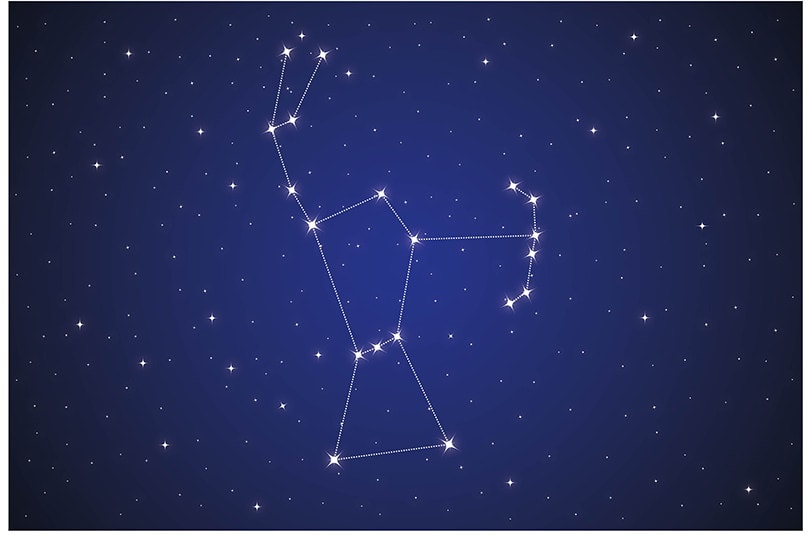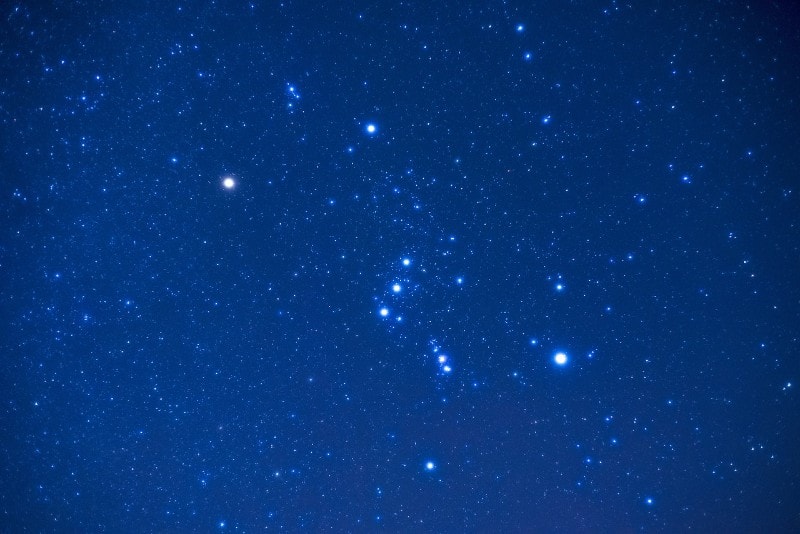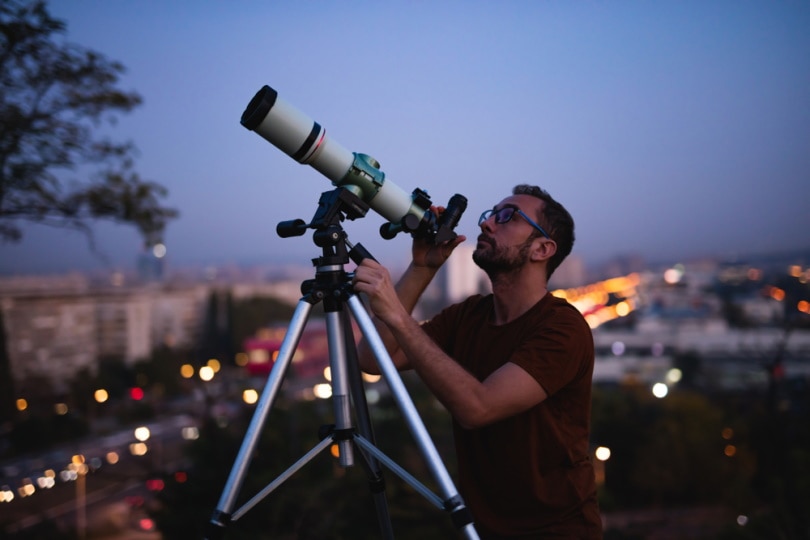14 Interesting Orion Constellation Facts, Myths, and FAQs
Last Updated on

Orion is easily one of the most recognizable constellations in the night sky. Since it’s extremely popular, there are many interesting facts and myths about the constellation.
Many people also have questions about Orion, and here, we do our best to answer them. If you’re interested in learning more about this popular constellation, you’ve come to the right place!

The 14 Orion Constellation Facts
1. Humans Identified the Orion Constellation at Least 32,000 Years Ago
The stars in the Orion constellation formed millions of years ago, though humans started noticing them a bit later than that! Still, with depictions of the Orion constellation showing up in cave paintings from over 32,000 years ago, it’s not exactly a new discovery.
But keep in mind that while humans noticed this constellation 32,000 years ago, they didn’t call it the Orion constellation, and they likely had their own mythologies about it.

2. Orion Is the 26th Largest Constellation
While Orion might be one of the most recognizable and well-known constellations in the sky, it’s far from the biggest. In fact, of the 88 International Astronomical Union-recognized constellations, Orion is the 26th largest. That’s still far up the list, but it’s not near the top!
3. The Orion Constellation Takes Up 594 Square Degrees
Speaking of size, how do we determine how big a constellation is in the sky? By how many square degrees that it takes up! With the Orion constellation, that number equals 594 square degrees, which means it takes up a big portion of the sky.
4. There Are 10 Named Stars in the Orion Constellation
While there are many stars in the Orion constellation, only 10 have formally recognized names: Alnilam, Alnitak, Bellatrix, Betelgeuse, Hatysa, Meissa, Mintaka, Rigel, Saiph, and Tabit. These are only a fraction of the total number of stars in the Orion constellation, though.

5. There Are 81 Total Stars in the Orion Constellation
While only 10 of the stars in the Orion constellation have official names, there are far more stars there. There are seven main stars and 81 total stars in the Orion constellation, but you can only see most of these stars if you’re in an area with optimal viewing conditions.
6. You Can Best See Orion From November to February in the Northern Hemisphere
You can only see certain constellations at certain parts of the year, and Orion is no different. This constellation is visible throughout the northern hemisphere from November to February, so if you want to get the best view of this constellation, you’ll need to head out on a cold fall or winter night.
7. You Can Best See Orion in the Summer in the Southern Hemisphere
While you can see Orion best during the cooler months in the northern hemisphere, in the southern hemisphere, the opposite is true. You can see Orion best in the southern hemisphere throughout the summer months, meaning you should head out during warm summer nights to get the best view of the constellation.

8. There Are Three Messier Objects in Orion
Messier objects are among the most recognized and highly sought-after deep sky objects for backyard astronomers, and if you’re trying to track them down, having the ability to locate the Orion constellation makes things easier.
Three of the Messier objects are within Orion itself. These are the Orion Nebula (M42), the De Mairan’s Nebula (M43), and Messier 78.
9. The Horsehead Nebula, Barnard’s Loop, Flame Nebula, and Monkey Head Nebula Are All Inside Orion
While there are three Messier objects inside the Orion constellation, they’re far from the only recognizable deep-sky objects within the constellation. The Horsehead Nebula, Barnard’s Loop, Flame Nebula, and Monkey Head Nebula also reside within the Orion constellation.
10. The Main Stars in the Orion Constellation Are Between 243 and 1,360 Light Years From Earth
When you look up at the Orion constellation, it can be easy to assume that those stars are close to each other. But the seven main stars in the Orion constellation actually range from 243 to 1,360 lightyears from Earth!
For reference, that means the closest main star from Orion is more than five times closer to Earth than the farthest main star in the constellation.

11. Six of the Seven Main Stars in Orion Are Bright Young Blue Giants or Supergiants
While the stars in the Orion constellation might be far apart, they have quite a bit in common. Of the seven different main stars in the Orion constellation, all but one are bright young blue giants or supergiants.
12. Betelgeuse Is a Main Star in Orion and Is a Red Giant
The only star that doesn’t fit the mold is Betelgeuse. It’s a main star in the Orion constellation, but it’s a red giant. It’s also a massive star compared to both our Sun and the other stars in the Orion constellation.
13. Betelgeuse Is Between 550 and 920 Times Larger Than the Sun
Betelgeuse’s size is mind-boggling compared to the Earth. At any given moment, it sits between 550 and 920 times the size of Earth. But this large range isn’t because we can’t narrow it down further, the diameter actually changes this much!
At its largest point, the diameter of Betelgeuse would stretch all the way from the Sun’s current location to Jupiter!

14. Rigel Is the Brightest Star in Orion
If you’re trying to figure out the brightest star in the Orion constellation, you might think that the honor would fall to the largest star there. But Rigel is the brightest star in Orion, and it’s the seventh brightest star in the sky.
It’s 120,000 times as bright as our Sun and more than twice as hot. Moreover, Rigel is 79 times larger in diameter than the Sun but only has 21 times the mass.

Orion Constellation Mythology
It’s time to learn about the mythology behind the name. According to Greek mythology, Orion was a Greek hunter who was extremely handsome and the son of Poseidon. Orion is mentioned in “The Odyssey” and wields an unbreakable bronze club.
There are a few different stories about how Orion ended up in the sky. Some legends say that he fell in love with Pleiades, others say with Merope. Most legends claim that Orion died in a fight with a scorpion, which gives extra meaning to Scorpius in the night sky.

Final Thoughts
Now that you know more about Orion, all that’s left is for you to try to spot the constellation for yourself! Most people start by tracking down the three stars in a row that make up Orion’s belt and then go from there.
Keep your gaze starward, and keep asking questions because when it comes to space and even the Orion constellation, as there’s still so much to learn!
Featured Image Credit: Ad_hominem, Shutterstock
Table of Contents
- The 14 Orion Constellation Facts
- 1. Humans Identified the Orion Constellation at Least 32,000 Years Ago
- 2. Orion Is the 26th Largest Constellation
- 3. The Orion Constellation Takes Up 594 Square Degrees
- 4. There Are 10 Named Stars in the Orion Constellation
- 5. There Are 81 Total Stars in the Orion Constellation
- 6. You Can Best See Orion From November to February in the Northern Hemisphere
- 7. You Can Best See Orion in the Summer in the Southern Hemisphere
- 8. There Are Three Messier Objects in Orion
- 9. The Horsehead Nebula, Barnard’s Loop, Flame Nebula, and Monkey Head Nebula Are All Inside Orion
- 10. The Main Stars in the Orion Constellation Are Between 243 and 1,360 Light Years From Earth
- 11. Six of the Seven Main Stars in Orion Are Bright Young Blue Giants or Supergiants
- 12. Betelgeuse Is a Main Star in Orion and Is a Red Giant
- 13. Betelgeuse Is Between 550 and 920 Times Larger Than the Sun
- 14. Rigel Is the Brightest Star in Orion
- Orion Constellation Mythology
- Final Thoughts
About the Author Robert Sparks
Robert’s obsession with all things optical started early in life, when his optician father would bring home prototypes for Robert to play with. Nowadays, Robert is dedicated to helping others find the right optics for their needs. His hobbies include astronomy, astrophysics, and model building. Originally from Newark, NJ, he resides in Santa Fe, New Mexico, where the nighttime skies are filled with glittering stars.
Related Articles:
15 Crucial Facts About Ultraviolet Rays & the Sun
What Constellation Is Spica In? The Interesting Answer!
10 Interesting Leo Constellation Facts, Myths, and FAQs
15 Interesting Pegasus Constellation Facts, Myths, and FAQs
6 Interesting Sagittarius Constellation Facts, Myths, and FAQs in 2024!
What Are Constellations? Where Did They Come From?
8 Interesting Libra Constellation Facts, Myths, and FAQs
What Is Infrared Radiation? Science-Based Facts & FAQ
